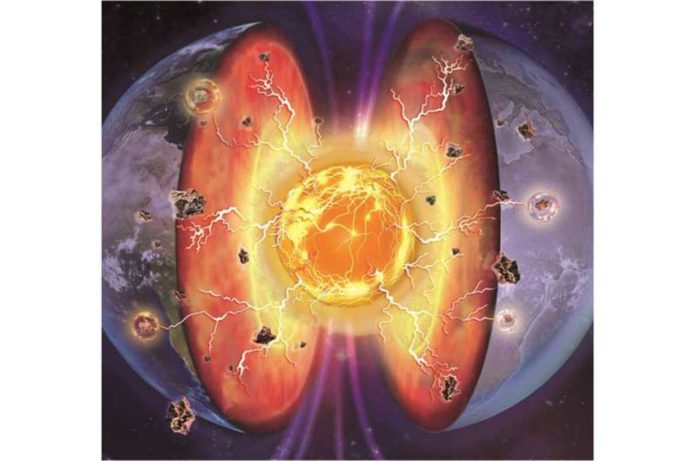Water ice becomes a superionic phase under the high pressure and temperature conditions of deep planetary interiors of ice planets such as Neptune and Uranus, which affect interior structures and generates magnetic fields.
In Earth’s case, three-quarters of Earth‘s surface is covered by water; standalone water or ice rarely exists in Earth’s interiors. The most common unit of water is hydroxyl. The solid Earth contains only hydrous minerals with a negligible amount of ice.
A recent study by the Center for High-Pressure Science & Technology Advanced Research discovered that one such hydrous mineral also enters an exotic superionic phase, similar to water ice in giant planets.
Dr. Qingyang Hu from the Center for High-Pressure Science and Technology Advanced Research said, “In superionic water, hydrogen will get released from oxygen and become liquid-like, and move freely within the solid oxygen lattice. Similarly, we studied a hydrous mineral iron oxide-hydroxide (FeOOH), and the hydrogen atoms move freely in the solid oxygen lattice of FeO2.”
Dr. Duckyoung Kim from the Center for High-Pressure Science and Technology Advanced Research said, “It developed into the superionic phase above about 1700°C and 800,000 times normal atmospheric pressure. Such pressure and temperature conditions ensure a large portion of Earth’s lower mantle can host the superionic hydrous mineral. These deep regions may have rivers made of protons, which flow through the solids.”
By combining high pressure and temperature electrical conductivity experiments, Raman spectroscopy, and first-principles simulations, scientists investigated the state of hydrogen in the pyrite-type FeO2Hx, a potential H-bearing phase near the core-mantle boundary.
Dr. Hu, one of the lead authors, said, “It is technically challenging to recognize the motion of H atoms experimentally; however, the evolution of O-H bonding is sensitive to Raman spectroscopy. So, we tracked the evolution of the O-H bond and captured this exotic state in its ordinary form.”
When the pressure increases beyond 73 GPa at room temperature, the O-H bonding softens abruptly, and the H+ becomes diffusive within the vicinity of its crystallographic site. These results indicate that some H+ may be delocalized from oxygen and become mobile, thus, weakening the O-H bonding, consistent with simulations.
Dr. Hu said, “The softening and weakening of the O-H bonding at high-pressure and room-temperature conditions can only be regarded as a precursor of the superionic state because high temperature is required to increase the mobility beyond the unit cell.”
Scientists measured the electrical-conductivity evolution of the sample at high-temperature and pressure conditions. They observed an abrupt increase in electrical conductivity around 1500-1700°C and 121,000 times normal atmospheric pressure, indicating the diffusive hydrogen had covered the entire solid sample and thus, entered a superionic state.
Dr. Liu, a co-lead author of the work, said, “The pyrite-type FeO2Hx is just the first example of superionic phases in the deep lower mantle. It is very likely that hydrogen in the recently-discovered dense hydrogen-bearing oxides that are stable under the deep lower mantle’s high P-T conditions, such as dense hydrous phases, may also exhibit superionic behavior.”
Journal Reference:
- Mingqiang Hou et al. Superionic iron oxide–hydroxide in Earth’s deep mantle, Nature Geoscience (2021). DOI: 10.1038/s41561-021-00696-2
